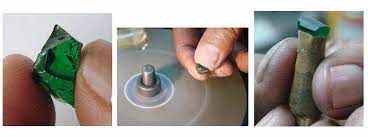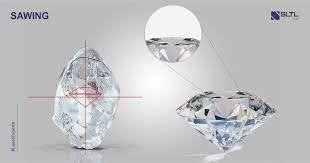Production Manager (Handmade Jewellery)
CTOR: INFORMATION TECHNOLOGY- INFORMATION TECHNOLOGY ENABLED SERVICES (ITITES)ces Helpdesk Attendant
SECTOR: GEMS & JEWELLERY
SUB-SECTOR: Handmade gold and gems-set jewellery
OCCUPATION: Managing (Company)
REFERENCE ID: G&J/Q0101
Production Manager: Also known as ‘Head Job-work’ or ‘Manager’, the
Production Manager of the company is responsible for planning and overseeing
the production of jewellery.
ALIGNED TO: NCO-2004/NIL
Brief Job Description: The individual at work needs to understand the
requirements of customers, plan and monitor the production process,
coordinate with other department of the unit and ensure that quality product is
delivered on time and as per order.
Personal Attributes: The job requires the individual to have: attention to
details; strategic thinking; ability to manage a process driven team and
leadership qualities. The individual must have ability to motivate and manage
team.
Unit Code G&J/N0101
Unit Title
(Task) Plan and monitor production process
Description This OS unit is about planning and managing the production process and enable timely
shipments to clients by recruiting the team and managing it along with the production
process and planning.
Scope This unit/task covers the following:
Understand the production schedule and customer’s requirements
Plan the production process
Ensure smooth production process
Monitor and execute the production process
Record the production data
Maintain the locker in the unit
Maintain pre-delivery standards
Control precious metal loss
Manage the human resource and assess their performance
Rectify problems
To be competent, the user/individual on the job must be able to:
PC1. understand customer’s requirement as passed on by the marketing and sales
team
PC2. design of the jewellery to decide on in-house manufacturing versus outsourcing
PC3. ensure quality, time of delivery, payment terms
PC4. ensure availability of raw materials and teams required
PC5. plan the time required for executing the work by calculating man hours
required to finish the work
PC6. interact with different department heads to firm up the plan
PC7. calculate the time required and finalise the production plan
PC8. allocate work and procurement schedule
PC9. critical products or requirements
PC10. gold quality procured i.e., karatage of gold is as per requirement
PC11. arrange for all supplies, tools and consumables
PC12. assess human resources and skills
PC13. take corrective action required for anticipated or actual problems and delays
PC14. undertake machine maintenance, hazards and accidents
PC15. achieve target movement from one department to another as planned
PC16. arrange for assaying of gold and jewellery as per customer requirement in
approved testing centre
PC17. allocate work requirement to each department heads / supervisor
PC18. ensure that right tools and equipment are used for the purpose
PC19. ensure adherence to job sheet schedule and requirements
PC20. motivate workers to achieve the planned production output
PC21. conduct random quality checks at different stages
PC22. assist on production when there is a technical issue
PC23. ensure daily production target is met
Maintain inventory
and production
records
To be competent, the user/individual on the job must be able to:
PC24. record the daily and production activities of the unit
PC25. keep track of gold and consumables given to each department and received
PC26. record the delivery date from each department
PC27. monitor locker movements and interact with locker manager
PC28. check records of finished jewellery placed in safe locker
PC29. check records of inventory of all raw material and components stored
PC30. ensure the jewellery is packed as per the company’s policy
PC31. ensure jewellery hallmarking
PC32. ensure company’s stamp on jewellery manufactured
Achieving
productivity
To be competent, the user/individual on the job must be able to:
PC33. understand the customers’ requirements of jewellery in terms of design,
quality, time of delivery, etc.
PC34. decide on accepting the work order from customer
PC35. plan the production process and move the production smoothly from one
department to another
PC36. deliver the jewellery goods to customer with expected quality
PC37. avoid delay in delivery of goods to customer
PC38. ensure all terms and conditions of the agreement with the customer is
followed during production
PC39. limit gold loss during production of jewellery
PC40. ensure that precious metal dust or fragments dispersed during the day is
collected by the workers properly
PC41. tally account as per allowed standards of gold loss
PC42. conduct regular cleaning for collection of gold as per company policy
PC43. train the workers on working effectively with control on gold loss
PC44. ensure that production all jewellery order results in profit for the company
PC45. complete work with minimum hazards and accidents
Handling problems To be competent, the user/individual on the job must be able to:
PC46. avoid process disruptions / delays and deliver goods on time
PC47. handle technical issues during production and provide solution
PC48. take corrective actions during human resource shortage, problem in machines,
etc.
PC49. address machine failure reported
PC50. arrange for fulfilling tools shortage and their maintenance related issues
PC51. avoid reasons for anticipated delays that may adversely affect delivery
PC52. return and replace poor quality of gold received
To be competent, the user/individual on the job must be able to:
PC53. train human resources on processes
PC54. allocated work to human resources and detail on work expected out of them
PC55. maintain record of their production in terms of quantity and quality
PC56. assess the skill and achievement of worker as per their output
PC57. recommend for recognition or training as per their performance
PC58. understand and resolve human resource conflicts in the unit
PC59. assess the performance of department supervisors in the unit
The individual on the job needs to know and understand:
KA1. company’s policies on: acceptable limits of precious metal loss per product
type, delivery timelines, safety and hazards, integrity and IPR, and personnel
management
KA2. work flow involved in jewellery manufacturing process of the company
KA3. management of worker, quality and productivity
KA4. conflict resolution and problem solving
KA5. performance appraisal
KA6. reporting structure
KA7. company’s budgeting, financial and pricing policy
B. Technical
Knowledge
The user/individual on the job needs to know and understand:
KB1. jewellery making process and different types of jewellery
KB2. machine and tools requirement for jewellery making
KB3. skilled worker from different region in the country to work on specialised
jewellery making
KB4. different methods and techniques involved in making the jewellery
KB5. making components and frames for jewellery
KB6. soldering techniques in jewellery making
KB7. different cleaning and polishing methods and their purpose
KB8. consumables used in different process of jewellery making and their usage
purpose
KB9. different type of gemstones and setting techniques
KB10. potential work hazards while using high speed rotating machines and
chemicals
KB11. assaying methods to determine purity of gold
KB12. accounting of jewellery and documentation
KB13. human resource management
KB14. team management
KB15. potential work hazards, particularly, when using hand and machine tools
KB16. operate computer system and software packages to document production
data and analyse
The user/individual on the job needs to know and understand how:
SA1. to read documents, agreement and design of jewellery
SA2. to record and document production of jewellery in the unit
Calculation skills
The user/individual on the job needs to know and understand how:
SA3. to plan for periodic production
SA4. to assess the number of human resource required for design
SA5. to assess the gold loss in each process
SA6. to calculate the productivity and do analysis on production data
Team management
The user/individual on the job needs to know and understand how:
SA7. to distribute work equitably and according to seniority and experience of
worker
SA8. to encourage workers to share workload and deliver on time
SA9. to assess worker requirements in terms of training, tools, machinery,
workspace and other facilities
SA10. to appraise based on company’s standards and workers’ performance
SA11. to encourage workers to multitask and work on different types of jewellery as
per their requirement
B. Professional Skills Communication skills
The individual on the job needs to know and understand how to:
SB1. give appropriate instructions and feedback to different levels of workers under
his supervision
SB2. educate about safety and work hazards
SB3. train on gold loss, productivity and correct steps to follow on the job
SB4. inform about IPR issues pertaining to the company and detecting violations
SB5. resolve inter-personal conflicts between workers and co-workers
Using tools and machines
The user/individual on the job needs to know and understand how:
SB6. to use different types of tools and machines are used for jewellery making at
different stages and what precautions are required in operating them in terms
of desired outcome and safety
SB7. to work in a safe environment, i.e., without injuries
Reflective thinking
The user/individual on the job needs to know and understand how to:
SB8. improve work processes for greater productivity
SB9. reduce gold loss
SB10. improve quality of output
SB11. Increase profitability of the company
The user/individual on the job needs to know and understand how:
SB12. to decide on the work can be executed with the available resources
SB13. to spot process disruptions and delays
SB14. to take corrective actions during issues in production
Unit Code G&J/N9910
Unit Title
(Task) Respect IPR of company as well as competitors
Description This OS unit is about maintaining company’s IPR and avoiding infringement on
copyright of others
Scope This unit/task covers the following:
Protect company’s Intellectual Property Rights (IPR)
Avoid infringement to copyright of other companies
Performance Criteria(PC) w.r.t. the Scope
Element Performance Criteria
Respecting IPR To be competent, the user/individual on the job must be able to:
PC1. prevent leak of new designs to competitors by reporting on time
PC2. spot any infringement of company’s product or design patents
PC3. report IPR violations observed in the market, to supervisor or company heads
PC4. read copyright clause of the material published on the internet and any other
printed material
PC5. consult supervisor or senior management when in doubt about using publicly
available information
PC6. report any infringement observed in the company
PC7. spot plagiarism and report
PC8. understand rationale of patents and IPR
PC9. avoid being involved in IPR violations
Knowledge and Understanding (K)
A. Organizational
Context
The individual on the job needs to know and understand:
KA1. company’s policies on IPR, plagiarism and order leaks
KA2. company’s patented products
KA3. market trends and company’s unique product range
KA4. reporting structure
B. Technical
Knowledge
The individual on the job needs to know and understand:
KB1. basics of patents and IPR laws
KB2. how IPR protection is important for competitiveness of a company
Skills (S) [Optional]
A. Core Skills/
Generic Skills
Communication skills
The user/individual on the job needs to know and understand how:
SA1. to effectively communicate any observed IPR violations or design leaks
B. Professional Skills Decision making
The user/individual on the job needs to know and understand when and how:
SB1. to report sources of IPR violations
The user/individual on the job needs to know and understand how:
SB2. to learn from past mistakes and report IPR violations on time
Critical thinking
The user/individual on the job needs to know and understand how:
SB3. to spot signs of violations and alert authorities in time
Unit Code G&J/N9913
Unit Title
(Task) Interact with colleagues and team members
Description This OS unit is about communicating with colleagues and seniors in order to maintain
smooth and hazard-free work flow
Scope This unit/task covers the following:
Interact with Seniors, Production Manager and others
Interact with colleagues
Performance Criteria(PC) w.r.t. the Scope
Element Performance Criteria
Interaction with
seniors
To be competent, the user/individual on the job must be able to:
PC1. receive or give work-flow instructions and quality standards
PC2. communicate about process flow improvements
PC3. communicate any potential hazards or expected disruptions
PC4. understand the work output requirements
PC5. comply with company policy and rule
PC6. deliver quality work on time as required by reporting any anticipated reasons
for delays
Interactions with
colleagues and other
departments
To be competent, the user/individual on the job must be able to:
PC7. work as a team with colleagues and seniors
PC8. share skills and train
PC9. communicate and discuss work flow related difficulties in order to find
solutions with mutual agreement
PC10. receive feedback and address concerns in order to complete work on time
PC11. put team over individual goals
PC12. resolve conflicts and multi-task
Knowledge and Understanding (K)
A. Organizational
Context
(Knowledge of the
company /
organization and
its processes)
The individual on the job needs to know and understand:
KA1. company’s policies on personnel management
KA2. work flow involved in company’s jewellery manufacturing process
KA3. importance of the individual’s role in the workflow
KA4. reporting structure
B. Technical
Knowledge
The individual on the job needs to know and understand:
KB1. how to communicate effectively
KB2. how to build team coordination
Skills (S) [Optional]
A. Core Skills/ Teamwork and some multitasking
The individual on the job needs to know and understand how:
SA1. to motivate team to work
SA2. to convince seniors about significant process changes
SA3. to share work load as required
SA4. to deliver product to next work process on time
B. Professional Skills Decision making
The individual on the job needs to know and understand:
SB1. how to report potential areas of disruptions to work process
SB2. when to report to senior and when to deal with a colleague depending on the
type of concern
Reflective thinking
The individual on the job needs to know and understand:
SB3. how to improve work process
Critical thinking
The individual on the job needs to know and understand:
SB4. how to spot process disruptions and delays
Unit Code G&J/N9914
Unit Title
(Task) Work towards having a safe work environment
Description This OS unit is about being aware of and communicating potential hazards and
dangers of accidents on the job
Scope This unit/task covers the following:
Understand potential sources of accidents
Communicate to reporting supervisor about hazards in time
Performance Criteria(PC) w.r.t. the Scope
Element Performance Criteria
Understanding of
potential sources of
accidents and
communicating
To be competent, the user/individual on the job must be able to:
PC1. avoid accidents related to use of potentially dangerous chemicals, gas torches,
sharp tools and hazards from machines
PC2. suggest process flow improvements to reduce anticipated or repetitive hazards
PC3. report mishandling of tools, machines or hazardous materials
PC4. identify electrical problems that could result in accident
PC5. spot and report potential hazards on time
PC6. follow company policy and rules regarding hazardous materials
PC7. deliver quality work on time as required by reporting any anticipated reasons
for delays
Knowledge and Understanding (K)
A. Organizational
Context
(Knowledge of the
company /
organization and
its processes)
The individual on the job needs to know and understand:
KA1. company’s policies on handling: harmful chemicals and sharp tools, safety and
hazards of machines, fire safety and, disposal of harmful chemicals and
materials
KA2. work flow involved in company’s jewellery manufacturing process
KA3. importance of the individual’s role in the workflow
KA4. reporting structure
B. Technical
Knowledge
The individual on the job needs to know and understand:
KB1. how different chemicals react and what could be the danger from them
KB2. how to use machines and tools without causing bodily harm
KB3. fire safety education
KB4. disposal of hazardous chemicals, tools and materials by following prescribed
environmental norms or as per company policy
Skills (S) [Optional]
A. Core Skills/
Generic Skills
Communication skills
The individual on the job needs to know and understand how:
SA1. to effectively communicate the danger
National Occupational Standard
G&J/N9914 Maintain safe work environment
20
B. Professional Skills Decision making
The individual on the job needs to know and understand:
SB1. importance of reporting potential sources of danger
SB2. appropriate actions to be taken in the event of an accident
SB3. process for disposing of hazardous materials, safely and following
environmental guidelines
Reflective thinking
The individual on the job needs to know and understand how:
SB4. to learn from past mistakes regarding use of hazardous machines or
chemicals or gas torches
Critical thinking
The individual on the job needs to know and understand:
SB5. how to spot danger
SB6. procedures to follow in the event of a fire or other hazard
Keywords /Terms Description
Sector Sector is a conglomeration of different business operations having similar
business and interests. It may also be defined as a distinct subset of the
economy whose components share similar characteristics and interests.
Sub-sector Sub-sector is derived from a further breakdown based on the
characteristics and interests of its components.
Occupation Occupation is a set of job roles, which perform similar/ related set of
functions in an industry.
Function Function is an activity necessary for achieving the key purpose of the
sector, occupation, or an area of work, which can be carried out by a
person or a group of persons. Functions are identified through functional
analysis and form the basis of OS.
Sub-function Sub-functions are sub-activities essential to fulfil the achieving the
objectives of the function.
Job role Job role defines a unique set of functions that together form a unique
employment opportunity in an organisation.
Occupational Standards
(OS)
OS specify the standards of performance an individual must achieve
when carrying out a function in the workplace, together with the
knowledge and understanding they need to meet that standard
consistently. Occupational Standards are applicable both in the Indian
and global contexts.
Performance Criteria Performance criteria are statements that together specify the standard of
performance required when carrying out a task.
National Occupational
Standards (OS)
NOS are occupational standards which apply uniquely in the Indian
context.
Qualifications Pack (QP) QP comprises the set of OS, together with the educational, training and
other criteria required to perform a job role. A QP is assigned a unique
qualifications pack code.
Unit Code Unit code is a unique identifier for an Occupational Standard, which is
denoted by an ‘N’
Unit Title Unit title gives a clear overall statement about what the incumbent
should be able to do.
Description Description gives a short summary of the unit content. This would be
helpful to anyone searching on a database to verify that this is the
appropriate OS they are looking for.
Scope Scope is a set of statements specifying the range of variables that an
individual may have to deal with in carrying out the function which have
a critical impact on quality of performance required.
Knowledge and
Understanding
Knowledge and understanding are statements which together specify the
technical, generic, professional and organisational specific knowledge
that an individual needs in order to perform to the required standard.
Organisational Context Organisational context includes the way the organisation is structured
and how it operates, including the extent of operative knowledge
managers have of their relevant areas of responsibility.
Technical Knowledge Technical knowledge is the specific knowledge needed to accomplish
specific designated responsibilities.
Core Skills/ Generic
Skills
Core skills or generic skills are a group of skills that are the key to learning
and working in today’s world. These skills are typically needed in any
work environment in today’s world. These skills are typically needed in
any work environment. In the context of the OS, these include
communication related skills that are applicable to most job roles.
Keywords /Terms Description
IPR Intellectual Property Rights
NOS National Occupational Standard(s)
NVQF National Vocational Qualifications Framework
NSQF National Qualifications Framework
NVEQF National Vocational Education Qualifications Framework
QP Qualifications Pack









